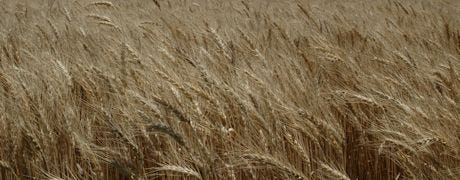June 27, 2013

Harvesting wheat early can accelerate soybean planting, but farmers must be aware of the differences between drying wheat and corn, says a University of Missouri Extension cereals specialist.
The USDA crop report for the week ending June 16 shows only 6% of the state's wheat crop harvested, 24 days behind last year and 14 days past normal. Most wheat in Missouri is harvested during a four- to six-week period beginning in late May in the south and ending by early July in the north, says Brent Myers.

Harvesting wet wheat is an option to accelerate soybean planting, but artificially drying wheat in summer requires more care than drying corn in fall.
Winter wheat harvest delays caused by abnormally low temperatures and excessive spring precipitation may reduce double-crop opportunities this year, creating additional concerns for producers who already face reduced corn yields due to late planting.
Research by MU Extension plant scientist Bill Wiebold shows that yields for soybean planted after June 15 are reduced by as much as 10 bushels per acre, and by 15 bushels per acre by July 1.
It may not be practical to wait for heads to ripen
Wheat should be harvested without delay when it reaches maturity. Waiting for all immature green heads to ripen may be impractical because field shatter can cause significant yield loss, Myers said.
After wheat begins to dry in the field, repeated precipitation and drying begins to decrease quality and test weight while increasing the potential for lodging and shattering losses, he said. One cause for low test weight in wheat is that rewetted kernels swell and maintain bulk, even after drying to the proper moisture level. Delayed harvest may also increase weed growth, which lodges in combines, resulting in reduced profits.
Prices for high-moisture wheat are discounted at grain elevators, so producers must carefully analyze the cost of harvest moisture and artificial drying. They must further weigh this against the potential losses due to a later soybean planting date.
Harvesting wet wheat is an option to accelerate soybean planting, but Myers says producers should be cautious and know the differences between artificial drying conditions for wheat and corn.
Be cautious when artificially drying wheat
Myers said drying wheat in the summer requires more care than drying corn in the fall. Wheat restricts airflow more than corn, so fans that provide sufficient air in a full bin of corn may fail to do so in wheat. Wheat also is harvested at the onset of some of the highest humidity of the year, while corn is harvested at the onset of cooler, drier conditions.
Wheat must be dried quickly, Myers said. If bins are not dried as they are filled, wet wheat at the top is likely to rot or sprout. If drying equipment is available and correct drying procedures are followed, then harvesting around 17% to 18% moisture content is possible, he said, but optimal harvest moisture is around 14%.
Recommendations for artificial drying, as well as combine adjustment for wheat, are included in the MU Extension publication "Management of Soft Red Winter Wheat" (IPM1022), available for free download at the Extension website.
Source: University of Missouri Extension
You May Also Like




